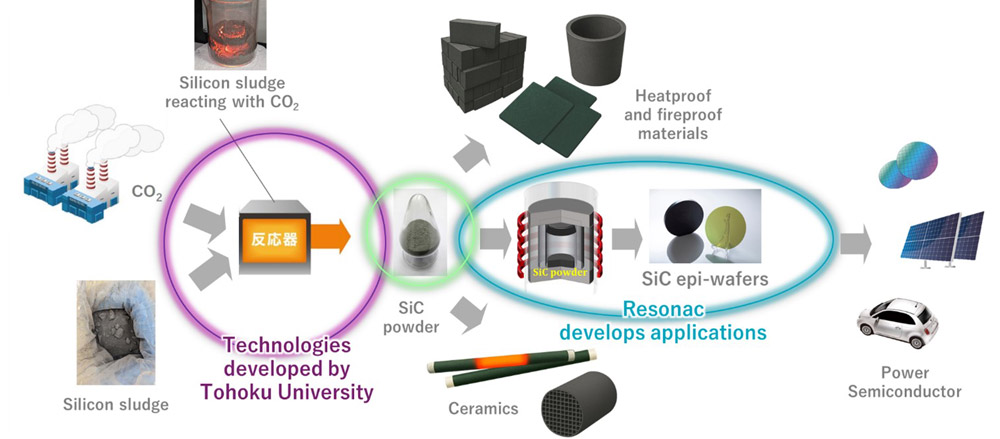News: Suppliers
16 July 2025
Resonac and Tohoku University synthesizing silicon carbide powder from silicon sludge and carbon dioxide
The synthesis of silicon carbide (SiC) requires high temperatures and significant power, posing challenges in reducing the environmental impact of the manufacturing process.
To address this challenge, since last year Tokyo-based wafer manufacturer Resonac Corp and Japan’s Tohoku University Graduate School of Engineering have been conducting fundamental research on the application of silicon carbide (SiC) powder — synthesized by reacting carbon dioxide (CO2) with silicon sludge (generated during the silicon wafer manufacturing process) — as raw material for the growth of SiC single-crystal materials used in power semiconductors.
In this study, Tohoku University synthesized SiC powder by heating silicon sludge and CO2 with microwaves at the carbon recycling demonstration research hub, while Resonac worked on applying the SiC powder to SiC single-crystal substrates. Recently, the fundamental research phase, including the characterization of the crystals, has been completed. Now, full-scale studies have been commenced, targeting practical applications.
The new technology applies carbon recycling techniques through ‘mineralization’, which involves reacting CO2 with solid materials. By recycling both silicon sludge and CO2, it creates raw materials for SiC. This approach is expected to serve as a low-environmental-impact technology, replacing conventional high-energy-consuming processes.

Picture: Recycling process for silicon sludge and CO2.
If this technology is commercialized, SiC power semiconductors will not only contribute to energy conservation as products but also enable reductions in CO2 emissions, the recycling of silicon sludge and the reutilization of CO2 simultaneously during the manufacturing process. This would reduce the overall environmental impact throughout the entire lifecycle of SiC power semiconductors.
“This technology, which enables the production of SiC wafers from CO2 and silicon sludge, has a significant impact both on the supply chain and on reducing environmental burdens,” says Yoshiteru Hosaka, theme leader, Technology Development Department, SiC Division, Device Solutions business unit, Resonac.
“The key feature of this process lies in its ability to transform CO2, which is stable gas, into high-purity SiC with low energy consumption, offering a promising solution to both waste management and greenhouse-gas reduction,” says Jun Fukushima, assistant professor, Department of Applied Chemistry, Graduate School of Engineering, Tohoku University.
“Looking ahead, we aim to expand its application across diverse fields such as electric vehicles and renewable energy sectors. By accumulating practical demonstrations, we seek to enhance industrial competitiveness and present concrete measures toward achieving carbon neutrality and a circular economy by 2050”.
Infineon signs new SiC material multi-year supply and cooperation deal with Resonac
Showa Denko’s 8-inch SiC wafer development project funded by NEDO









